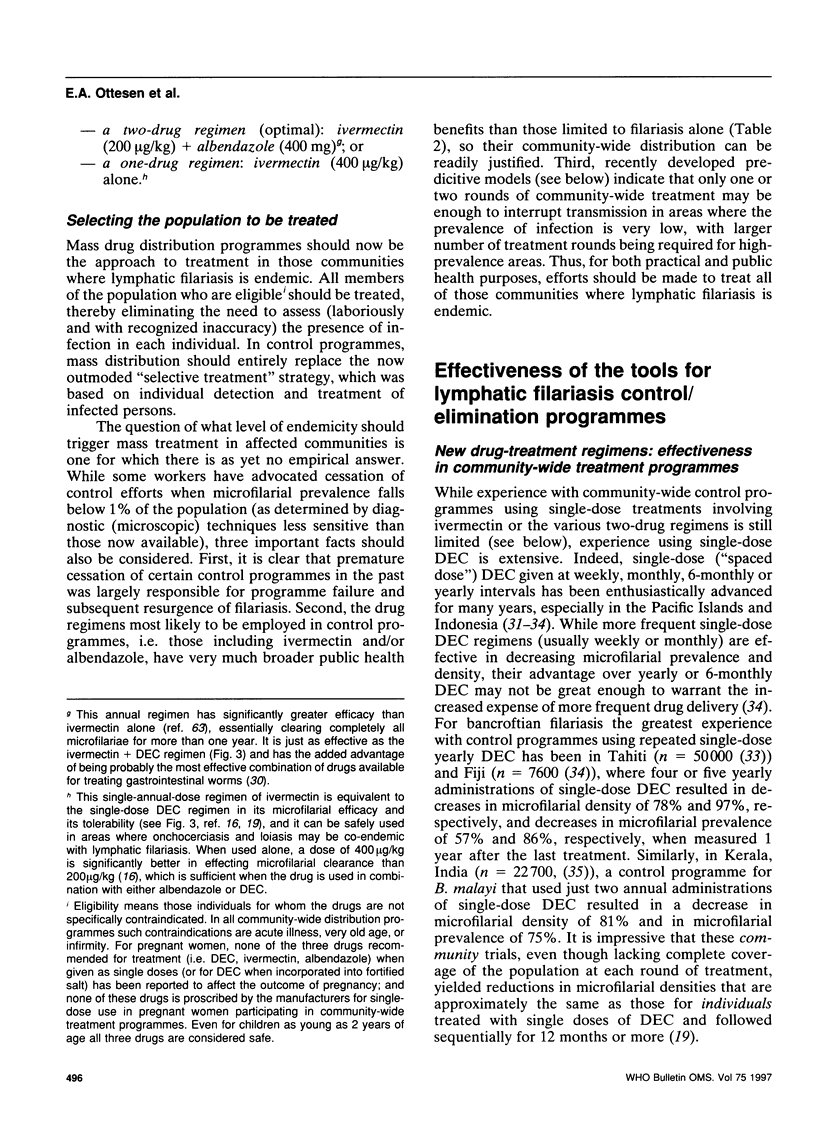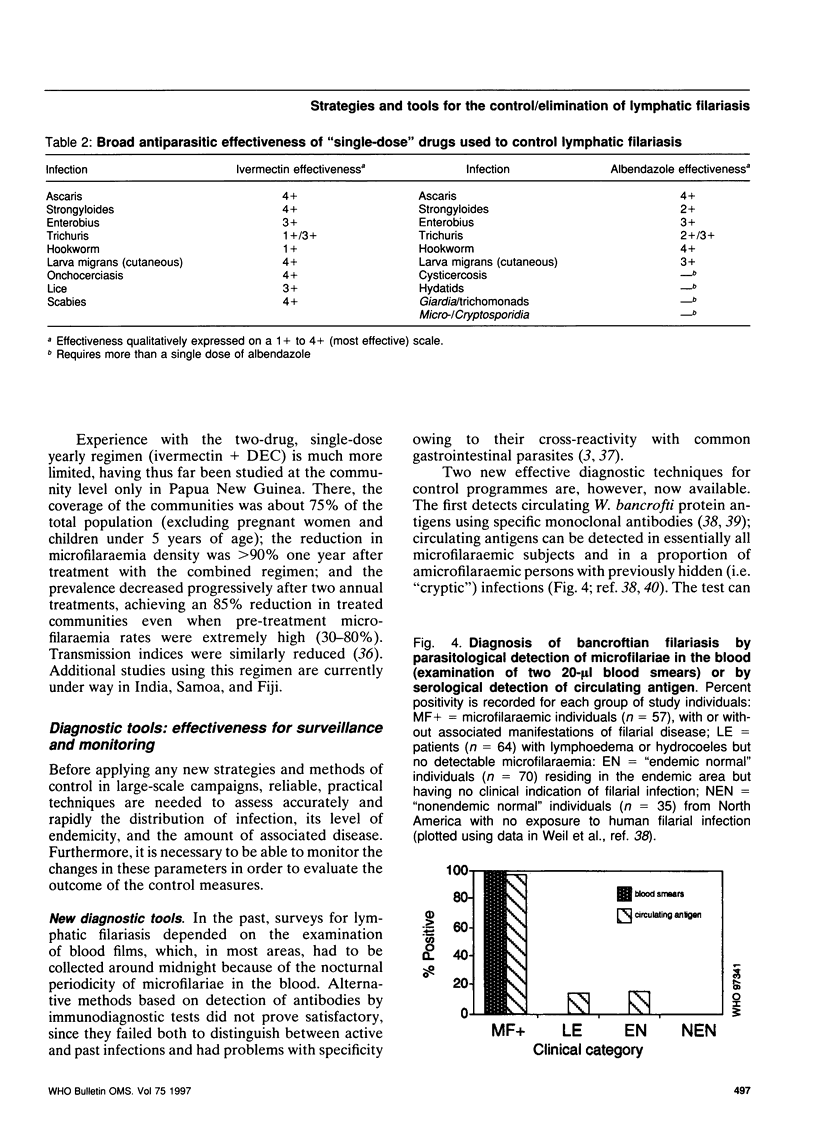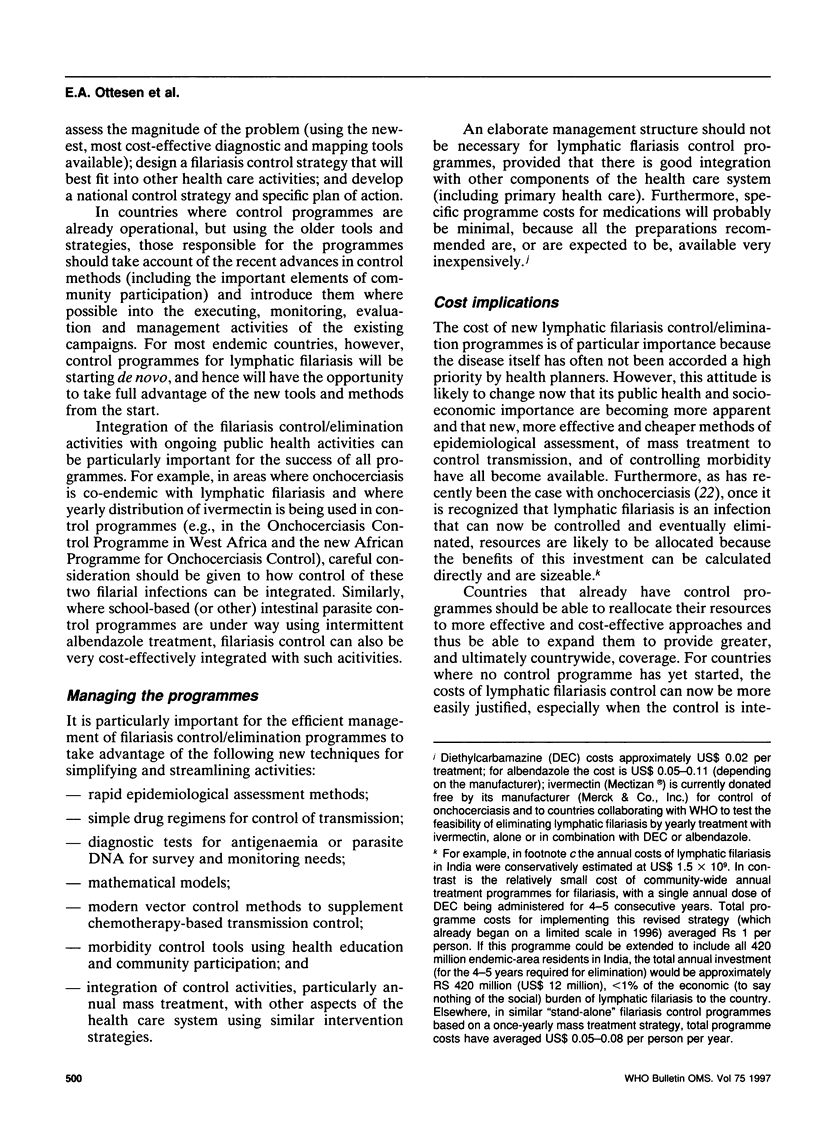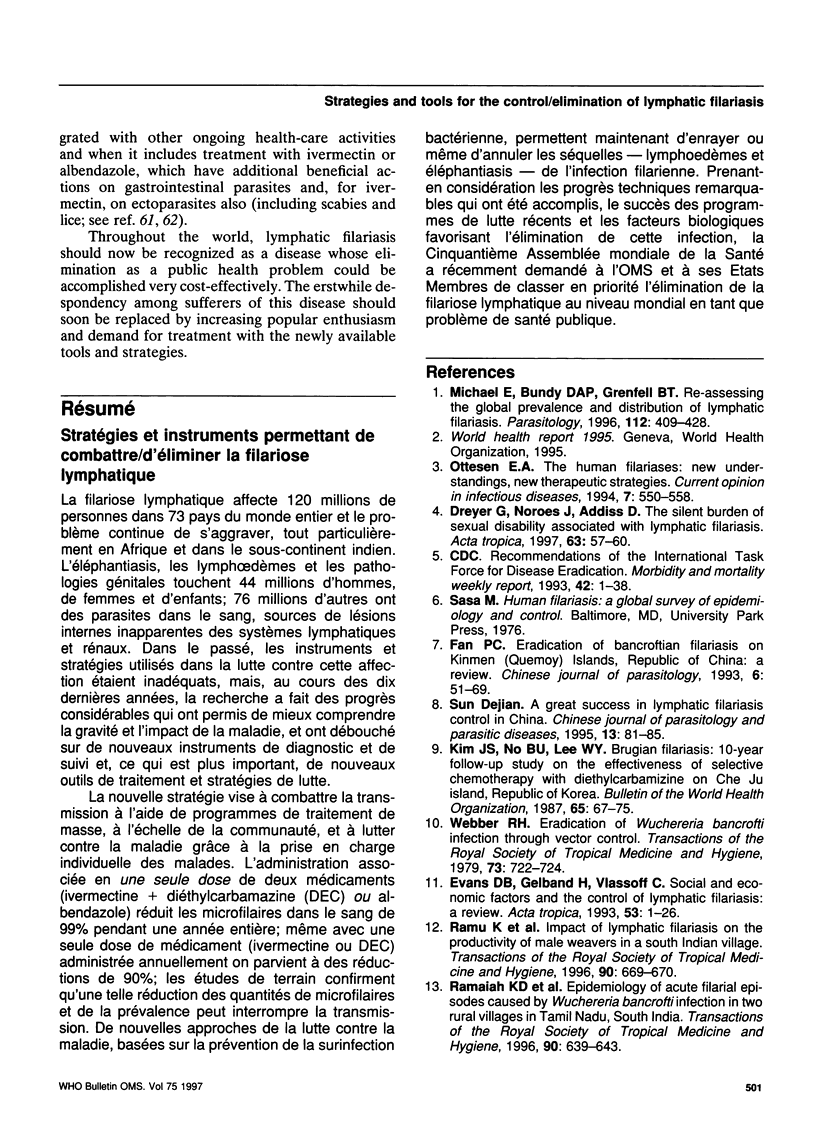Abstract
Lymphatic filariasis infects 120 million people in 73 countries worldwide and continues to be a worsening problem, especially in Africa and the Indian subcontinent. Elephantiasis, lymphoedema, and genital pathology afflict 44 million men, women and children; another 76 million have parasites in their blood and hidden internal damage to their lymphatic and renal systems. In the past, tools and strategies for the control of the condition were inadequate, but over the last 10 years dramatic research advances have led to new understanding about the severity and impact of the disease, new diagnostic and monitoring tools, and, most importantly, new treatment tools and control strategies. The new strategy aims both at transmission control through community-wide (mass) treatment programmes and at disease control through individual patient management. Annual single-dose co-administration of two drugs (ivermectin + diethylcarbamazine (DEC) or albendazole) reduces blood microfilariae by 99% for a full year; even a single dose of one drug (ivermectin or DEC) administered annually can result in 90% reductions; field studies confirm that such reduction of microfilarial loads and prevalence can interrupt transmission. New approaches to disease control, based on preventing bacterial superinfection, can now halt or even reverse the lymphoedema and elephantiasis sequelae of filarial infection. Recognizing these remarkable technical advances, the successes of recent control programmes, and the biological factors favouring elimination of this infection, the Fiftieth World Health Assembly recently called on WHO and its Member States to establish as a priority the global elimination of lymphatic filariasis as a public health problem.
Full text
PDF












Selected References
These references are in PubMed. This may not be the complete list of references from this article.
- Addiss D. G., Beach M. J., Streit T. G., Lutwick S., LeConte F. H., Lafontant J. G., Hightower A. W., Lammie P. J. Randomised placebo-controlled comparison of ivermectin and albendazole alone and in combination for Wuchereria bancrofti microfilaraemia in Haitian children. Lancet. 1997 Aug 16;350(9076):480–484. doi: 10.1016/S0140-6736(97)02231-9. [DOI] [PubMed] [Google Scholar]
- Addiss D. G., Eberhard M. L., Lammie P. J. "Filarial" adenolymphangitis without filarial infection. Lancet. 1994 Mar 5;343(8897):597–597. doi: 10.1016/s0140-6736(94)91547-4. [DOI] [PubMed] [Google Scholar]
- Cao W. C., Van der Ploeg C. P., Plaisier A. P., van der Sluijs I. J., Habbema J. D. Ivermectin for the chemotherapy of bancroftian filariasis: a meta-analysis of the effect of single treatment. Trop Med Int Health. 1997 Apr;2(4):393–403. doi: 10.1111/j.1365-3156.1997.tb00157.x. [DOI] [PubMed] [Google Scholar]
- Chanteau S., Luquiaud P., Failloux A. B., Williams S. A. Detection of Wuchereria bancrofti larvae in pools of mosquitoes by the polymerase chain reaction. Trans R Soc Trop Med Hyg. 1994 Nov-Dec;88(6):665–666. doi: 10.1016/0035-9203(94)90219-4. [DOI] [PubMed] [Google Scholar]
- Chanteau S., Moulia-Pelat J. P., Glaziou P., Nguyen N. L., Luquiaud P., Plichart C., Martin P. M., Cartel J. L. Og4C3 circulating antigen: a marker of infection and adult worm burden in Wuchereria bancrofti filariasis. J Infect Dis. 1994 Jul;170(1):247–250. doi: 10.1093/infdis/170.1.247. [DOI] [PubMed] [Google Scholar]
- Dreyer G., Addiss D., Noroes J., Amaral F., Rocha A., Coutinho A. Ultrasonographic assessment of the adulticidal efficacy of repeat high-dose ivermectin in bancroftian filariasis. Trop Med Int Health. 1996 Aug;1(4):427–432. doi: 10.1046/j.1365-3156.1996.d01-79.x. [DOI] [PubMed] [Google Scholar]
- Dreyer G., Coutinho A., Miranda D., Noroes J., Rizzo J. A., Galdino E., Rocha A., Medeiros Z., Andrade L. D., Santos A. Treatment of bancroftian filariasis in Recife, Brazil: a two-year comparative study of the efficacy of single treatments with ivermectin or diethylcarbamazine. Trans R Soc Trop Med Hyg. 1995 Jan-Feb;89(1):98–102. doi: 10.1016/0035-9203(95)90674-6. [DOI] [PubMed] [Google Scholar]
- Dreyer G., Norões J., Addiss D. The silent burden of sexual disability associated with lymphatic filariasis. Acta Trop. 1997 Jan;63(1):57–60. doi: 10.1016/s0001-706x(96)00604-3. [DOI] [PubMed] [Google Scholar]
- Dreyer G., Ottesen E. A., Galdino E., Andrade L., Rocha A., Medeiros Z., Moura I., Casimiro I., Beliz F., Coutinho A. Renal abnormalities in microfilaremic patients with Bancroftian filariasis. Am J Trop Med Hyg. 1992 Jun;46(6):745–751. doi: 10.4269/ajtmh.1992.46.745. [DOI] [PubMed] [Google Scholar]
- Dreyer G., Pires M. L., de Andrade L. D., Lopes E., Medeiros Z., Tenorio J., Coutinho A., Noroes J., Figueredo-Silva J. Tolerance of diethylcarbamazine by microfilaraemic and amicrofilaraemic individuals in an endemic area of Bancroftian filariasis, Recife, Brazil. Trans R Soc Trop Med Hyg. 1994 Mar-Apr;88(2):232–236. doi: 10.1016/0035-9203(94)90311-5. [DOI] [PubMed] [Google Scholar]
- Evans D. B., Gelband H., Vlassoff C. Social and economic factors and the control of lymphatic filariasis: a review. Acta Trop. 1993 Mar;53(1):1–26. doi: 10.1016/0001-706x(93)90002-s. [DOI] [PubMed] [Google Scholar]
- Freedman D. O., de Almeida Filho P. J., Besh S., Maia e Silva M. C., Braga C., Maciel A. Lymphoscintigraphic analysis of lymphatic abnormalities in symptomatic and asymptomatic human filariasis. J Infect Dis. 1994 Oct;170(4):927–933. doi: 10.1093/infdis/170.4.927. [DOI] [PubMed] [Google Scholar]
- Gelband H. Diethylcarbamazine salt in the control of lymphatic filariasis. Am J Trop Med Hyg. 1994 Jun;50(6):655–662. doi: 10.4269/ajtmh.1994.50.655. [DOI] [PubMed] [Google Scholar]
- Gyapong J. O., Adjei S., Gyapong M., Asamoah G. Rapid community diagnosis of lymphatic filariasis. Acta Trop. 1996 Mar;61(1):65–74. doi: 10.1016/0001-706x(95)00141-z. [DOI] [PubMed] [Google Scholar]
- Hougard J. M., Mbentengam R., Lochouarn L., Escaffre H., Darriet F., Barbazan P., Quillévéré D. Lutte contre Culex quinquefasciatus par Bacillus sphaericus: résultats d'une campagne pilote dans une grande agglomération urbaine d'Afrique équatoriale. Bull World Health Organ. 1993;71(3-4):367–375. [PMC free article] [PubMed] [Google Scholar]
- Kim J. S., No B. U., Lee W. Y. Brugian filariasis: 10-year follow-up study on the effectiveness of selective chemotherapy with diethylcarbamazine on Che Ju island, Republic of Korea. Bull World Health Organ. 1987;65(1):67–75. [PMC free article] [PubMed] [Google Scholar]
- Kimura E., Penaia L., Spears G. F. The efficacy of annual single-dose treatment with diethylcarbamazine citrate against diurnally subperiodic bancroftian filariasis in Samoa. Bull World Health Organ. 1985;63(6):1097–1106. [PMC free article] [PubMed] [Google Scholar]
- Kumaraswami V., Ottesen E. A., Vijayasekaran V., Devi U., Swaminathan M., Aziz M. A., Sarma G. R., Prabhakar R., Tripathy S. P. Ivermectin for the treatment of Wuchereria bancrofti filariasis. Efficacy and adverse reactions. JAMA. 1988 Jun 3;259(21):3150–3153. [PubMed] [Google Scholar]
- Laigret J., Fagneaux G., Tuira E. Chimiothérapie de masse par la diéthylcarbamazine en doses espacées: effets obtenus à tahiti sur la microfilarémie à Wuchereria bancrofti, var. pacifica. Bull World Health Organ. 1980;58(5):779–783. [PMC free article] [PubMed] [Google Scholar]
- Lammie P. J., Hightower A. W., Eberhard M. L. Age-specific prevalence of antigenemia in a Wuchereria bancrofti-exposed population. Am J Trop Med Hyg. 1994 Sep;51(3):348–355. doi: 10.4269/ajtmh.1994.51.348. [DOI] [PubMed] [Google Scholar]
- Maxwell C. A., Curtis C. F., Haji H., Kisumku S., Thalib A. I., Yahya S. A. Control of Bancroftian filariasis by integrating therapy with vector control using polystyrene beads in wet pit latrines. Trans R Soc Trop Med Hyg. 1990 Sep-Oct;84(5):709–714. doi: 10.1016/0035-9203(90)90158-b. [DOI] [PubMed] [Google Scholar]
- McCarthy J. S., Guinea A., Weil G. J., Ottesen E. A. Clearance of circulating filarial antigen as a measure of the macrofilaricidal activity of diethylcarbamazine in Wuchereria bancrofti infection. J Infect Dis. 1995 Aug;172(2):521–526. doi: 10.1093/infdis/172.2.521. [DOI] [PubMed] [Google Scholar]
- Meyrowitsch D. W., Simonsen P. E., Makunde W. H. Mass diethylcarbamazine chemotherapy for control of bancroftian filariasis through community participation: comparative efficacy of a low monthly dose and medicated salt. Trans R Soc Trop Med Hyg. 1996 Jan-Feb;90(1):74–79. doi: 10.1016/s0035-9203(96)90485-x. [DOI] [PubMed] [Google Scholar]
- Michael E., Bundy D. A., Grenfell B. T. Re-assessing the global prevalence and distribution of lymphatic filariasis. Parasitology. 1996 Apr;112(Pt 4):409–428. doi: 10.1017/s0031182000066646. [DOI] [PubMed] [Google Scholar]
- Moulia-Pelat J. P., Glaziou P., Weil G. J., Nguyen L. N., Gaxotte P., Nicolas L. Combination ivermectin plus diethylcarbamazine, a new effective tool for control of lymphatic filariasis. Trop Med Parasitol. 1995 Mar;46(1):9–12. [PubMed] [Google Scholar]
- Ottesen E. A. Efficacy of diethylcarbamazine in eradicating infection with lymphatic-dwelling filariae in humans. Rev Infect Dis. 1985 May-Jun;7(3):341–356. doi: 10.1093/clinids/7.3.341. [DOI] [PubMed] [Google Scholar]
- Ottesen E. A. Filarial infections. Infect Dis Clin North Am. 1993 Sep;7(3):619–633. [PubMed] [Google Scholar]
- Ottesen E. A. Immunological aspects of lymphatic filariasis and onchocerciasis in man. Trans R Soc Trop Med Hyg. 1984;78 (Suppl):9–18. doi: 10.1016/0035-9203(84)90309-2. [DOI] [PubMed] [Google Scholar]
- Panicker K. N., Krishnamoorthy K., Sabesan S., Prathiba J., Abidha Comparison of effects of mass annual and biannual single dose therapy with diethylcarbamazine for the control of Malayan filariasis. Southeast Asian J Trop Med Public Health. 1991 Sep;22(3):402–411. [PubMed] [Google Scholar]
- Partono F., Purnomo, Soewarta A., Oemijati S. Low dosage diethylcarbamazine administered by villagers for the control of timorian filariasis. Trans R Soc Trop Med Hyg. 1984;78(3):370–372. doi: 10.1016/0035-9203(84)90124-x. [DOI] [PubMed] [Google Scholar]
- Ramaiah K. D., Ramu K., Kumar K. N., Guyatt H. Epidemiology of acute filarial episodes caused by Wuchereria bancrofti infection in two rural villages in Tamil, Nadu, south India. Trans R Soc Trop Med Hyg. 1996 Nov-Dec;90(6):639–643. doi: 10.1016/s0035-9203(96)90415-0. [DOI] [PubMed] [Google Scholar]
- Ramu K., Ramaiah K. D., Guyatt H., Evans D. Impact of lymphatic filariasis on the productivity of male weavers in a south Indian village. Trans R Soc Trop Med Hyg. 1996 Nov-Dec;90(6):669–670. doi: 10.1016/s0035-9203(96)90426-5. [DOI] [PubMed] [Google Scholar]
- Reddy G. S., Venkateswaralu N. Mass administration of DEC-medicated salt for filariasis control in the endemic population of Karaikal, south India: implementation and impact assessment. Bull World Health Organ. 1996;74(1):85–90. [PMC free article] [PubMed] [Google Scholar]
- Vasuki V., Rajavel A. R. Beta-cyfluthrin, a synthetic pyrethroid for mosquito control. Southeast Asian J Trop Med Public Health. 1992 Jun;23(2):318–323. [PubMed] [Google Scholar]
- Webber R. H. Eradication of Wuchereria bancrofti infection through vector control. Trans R Soc Trop Med Hyg. 1979;73(6):722–724. doi: 10.1016/0035-9203(79)90031-2. [DOI] [PubMed] [Google Scholar]
- Weil G. J., Jain D. C., Santhanam S., Malhotra A., Kumar H., Sethumadhavan K. V., Liftis F., Ghosh T. K. A monoclonal antibody-based enzyme immunoassay for detecting parasite antigenemia in bancroftian filariasis. J Infect Dis. 1987 Aug;156(2):350–355. doi: 10.1093/infdis/156.2.350. [DOI] [PubMed] [Google Scholar]


